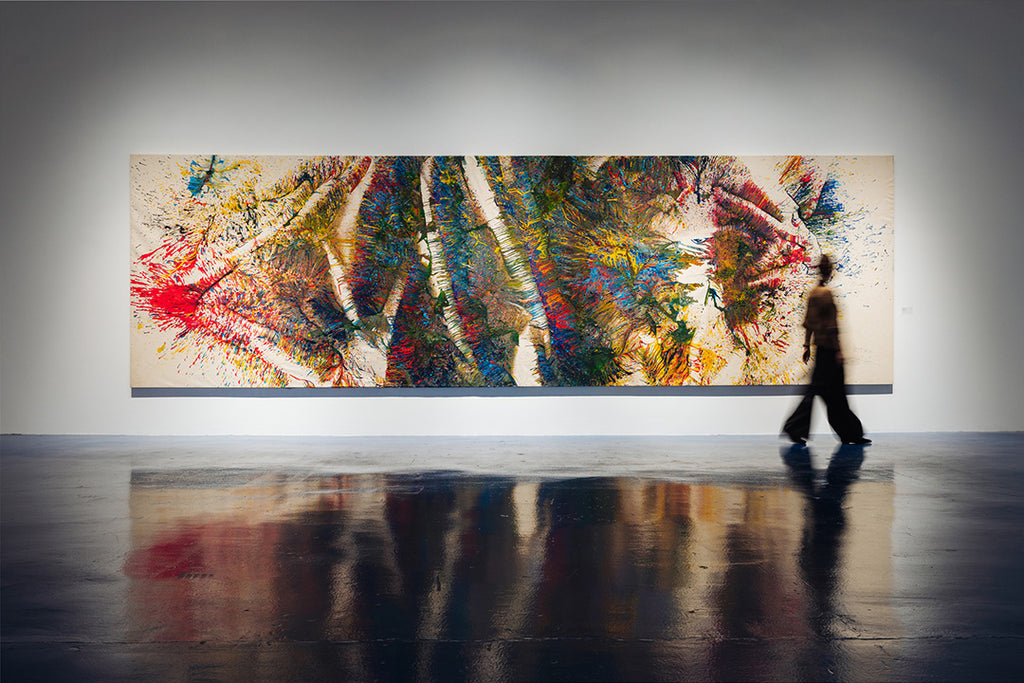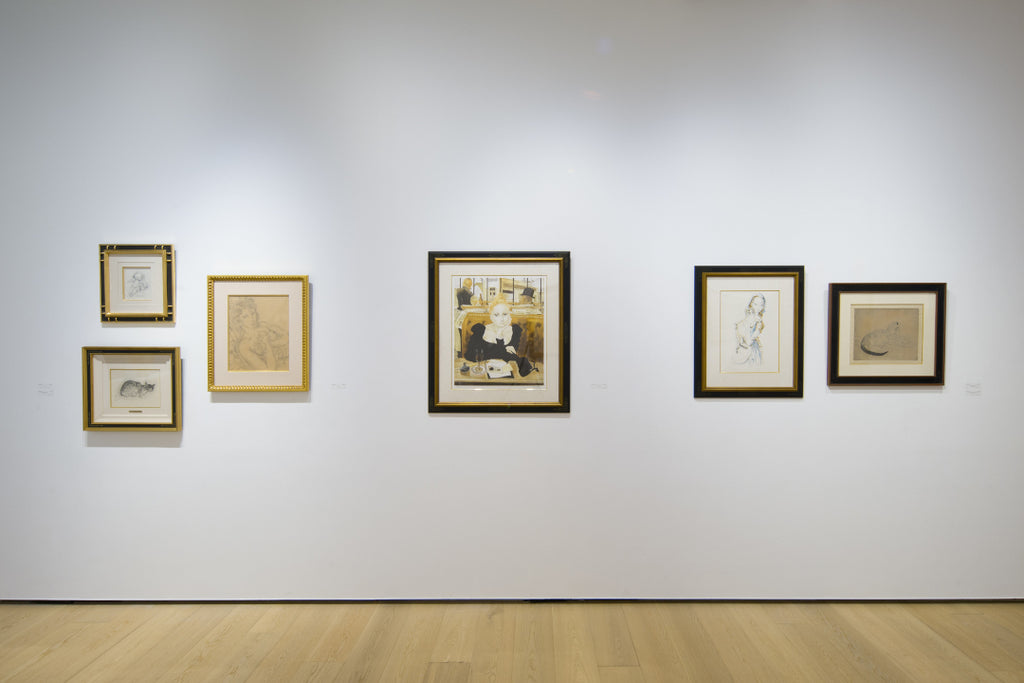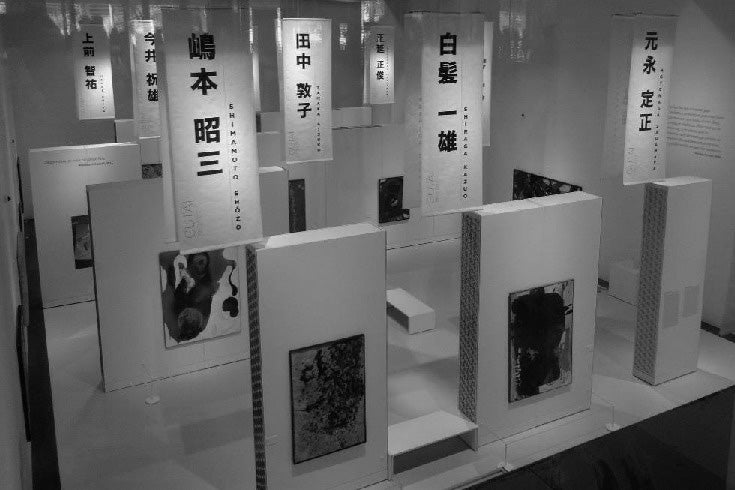ARTICLES
50 Years Since the End | The Gutai Art Association as seen at the National Museum of Art, Osaka
January 4, 2023
ART NEWS

"Into the Unknown World – GUTAI: Differentiation and Integration" exhibition installation view, National Museum of Art, Osaka
The Gutai Art Association was an avant-garde artist group that left an indelible mark on the postwar art history of Japan. To commemorate 50 years since the group's dissolution, a retrospective exhibition entitled "Into the Unknown World – GUTAI: Differentiation and Integration" is being held at Nakanoshima in Osaka, which used to be a base for Gutai's activities. It is a double exhibition held simultaneously at two museums that stand side by side. Here we introduce the show presented at the National Museum of Art.
Integrating GUTAI at the National Museum of Art

The exterior of the National Museum of Art, Osaka
"Into the Unknown World – GUTAI: Differentiation and Integration" is a rare exhibition held simultaneously at two venues. Presented under the two themes of "differentiation" and "integration," the exhibition seeks to create a new understanding of the art of Gutai.
The National Museum of Art, Osaka focuses on "integration" and explores how Gutai was not a monolithic organization and how each artist's practice changed over time. The exhibition here is presented under three thought-provoking themes: "The Handshake," "Empty Content," and "Not Limited to Painting."
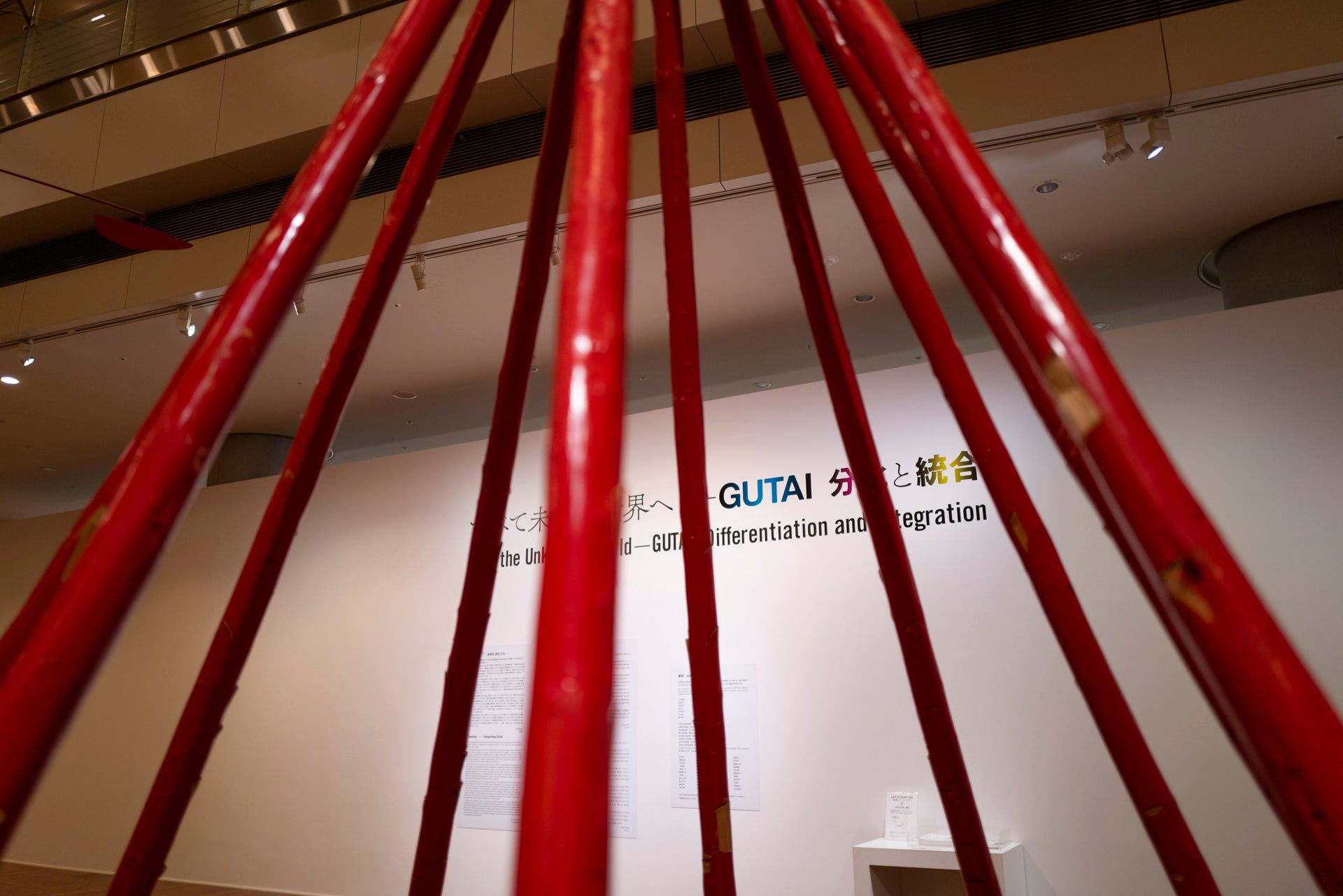
Installation view of Kazuo Shiraga's "Red Logs" (1955/85), Hyogo Prefectural Museum of Art (The Yamamura Collection)
The National Museum of Art, Osaka was designed with all exhibition spaces built underground. After exiting the elevator at the basement, visitors are immediately welcomed by Kazuo Shiraga's "Red Logs" (1955/85).
"The Handshake" between the Human Spirit and Material

"Into the Unknown World – GUTAI: Differentiation and Integration" exhibition installation view
The first section's title "The Handshake" is derived from a phrase in the "Gutai Art Manifesto" written by Gutai leader Jiro Yoshihara.
In Gutai art, the human spirit and the material shake hands with each other, even though they are in opposition. The material is not subjugated by the spirit. The spirit does not force the material into submission. When the material is left as it is and it reveals its qualities, it starts to tell a story, and even shouts it out. To keep the material alive is to bring life to the spirit. To lift the spirit up is to elevate the material to the height of the spirit.
"The human spirit and the material shake hands with each other, even though they are in opposition". This idea is embodied by the paintings in the exhibition room.
As you go around the room, you will encounter artworks that seek to find meaning and new possibilities in the materials they use. There is Chiyu Uemae's work made with matchsticks and old fabric, Michio Yoshihara's "Work A" features sand, pebbles, and coal tar spread all over plywood, and Fujiko Shiraga's "Work No.1" composed of paper and glass harmoniously arranged on a canvas. There are also the works of Shozo Shimamoto, who espoused the idea of "executing the paintbrush" and created paintings in unconventional ways, such as throwing glass bottles filled with paint onto a canvas.

Close-up of Michio Yoshihara's "Work A" (1959), Hyogo Prefectural Museum of Art (The Yamamura Collection)
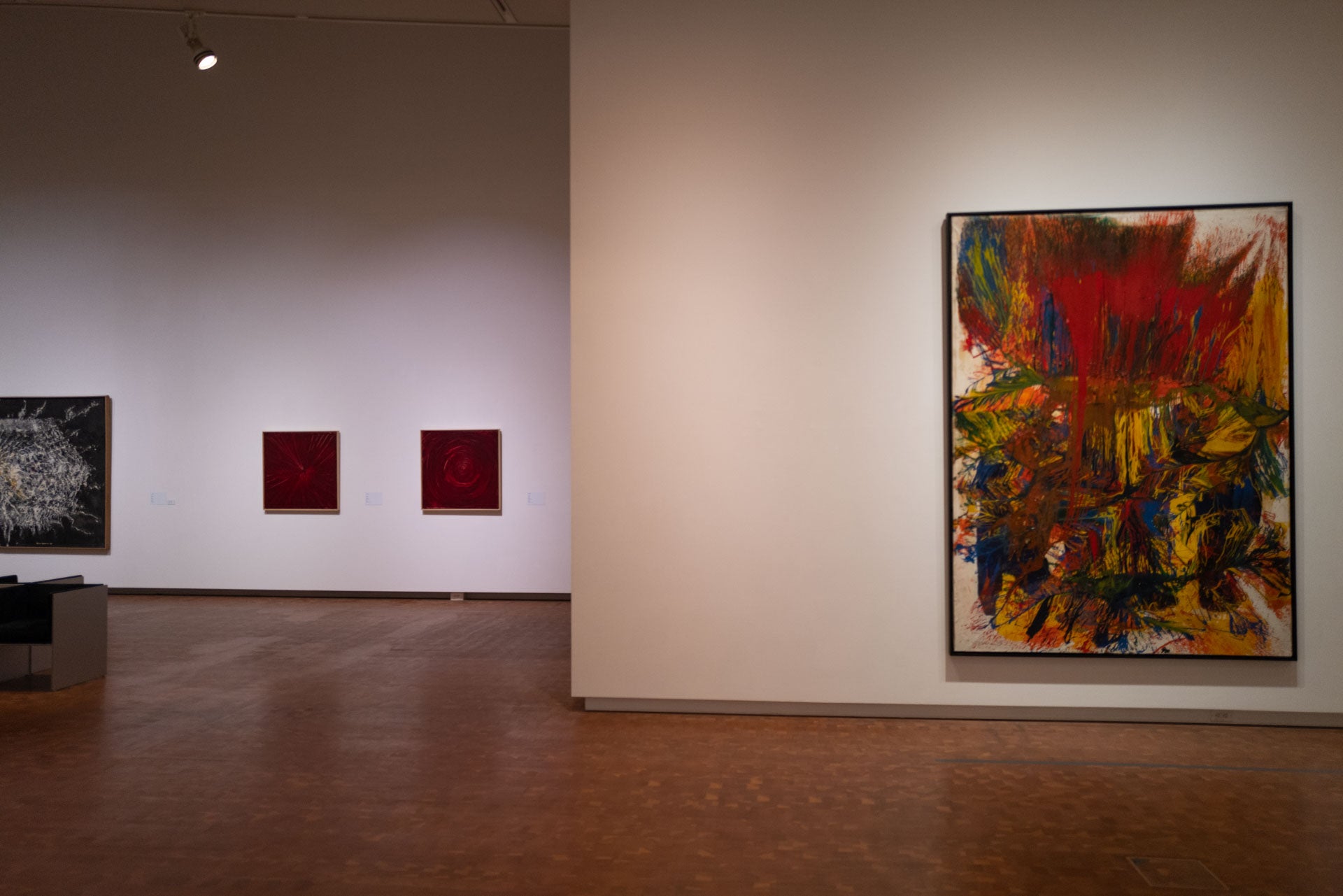
Installation view of Shozo Shimamoto's "1961-1" (1961) on the right, Nakanoshima Museum of Art, Osaka
On the other hand, some Gutai artists chose to use traditional painting materials but sought to find more freedom in expressing them. For example, Kazuo Shiraga was famous for sliding his bare feet to spread copious amounts of paint onto a canvas. Yasuo Sumi used objects like an abacus or comb to apply paint, while Akira Kanayama was known for creating paintings with a remote-controlled car.
Then there are the paintings by artists like Michimasa Naohara or Masatoshi Masanobu, who used short, rhythmic brush strokes to fill an entire canvas, and Yuko Nasaka, who made viewers disperse their gaze with her circular motifs. You can genuinely see how the handshake between the human spirit and the material can produce a fantastic diversity of art.

Close-up of Kazuo Shiraga's "Tenyusei Hyoshito" (1959), National Museum of Art, Osaka. The raw texture of the paint reveals the force used by the artist in its creation.

"Into the Unknown World – GUTAI: Differentiation and Integration" exhibition installation view

Left to right: Masatoshi Masanobu's "Work" (1960), National Museum of Art, Osaka. "Work '63・11" (1963), Hyogo Prefectural Museum of Art (The Yamamura Collection). "Work 64-3" (1964), Ashiya City Museum of Art & History.
Endless Ways to Experience "Empty Content"

"Into the Unknown World – GUTAI: Differentiation and Integration" exhibition installation view
Under Jiro Yoshihara's artistic philosophy, Gutai was famous for not giving explanations or even titles to their works, with only a few exceptions. Most of their artworks were named "Untitled" or simply "Work." In Chapter 2, "Empty Content," you can see how the members of Gutai sought freedom in their works and creative methods and how the viewers appreciated them.

"Into the Unknown World – GUTAI: Differentiation and Integration" exhibition installation view of Tsuruko Yamazaki's "Red" (1956/85), Hyogo Prefectural Museum of Art (The Yamamura Collection)
As you enter, you will inevitably be drawn to the grand but empty presence of Tsuruko Yamazaki's "Red." After you pass this empty red cube, you will come across a room that fills the exhibition space with a psychedelic atmosphere.
This room is filled with artwork that stimulates and stirs all your senses. In the words of Takashi Fukumoto, curator at the National Museum of Art, Osaka, "These works do not bear any form or meaning; they provide sensory stimulation. They take the act of appreciating art from the spiritual to the physical level."

"Into the Unknown World – GUTAI: Differentiation and Integration" exhibition installation view

Left to right: Joji Kikunami's "WORK-2-7-68" (1968), Ashiya City Museum of Art & History; Yuko Nasaka's "WORK" (1966), Nakanoshima Museum of Art, Osaka; Kumiko Imanaka's "Red and Yellow" (1966), National Museum of Art, Osaka
Artistic Expression that is "Not Limited to Painting"

"Into the Unknown World – GUTAI: Differentiation and Integration" exhibition installation view
The exhibition's last chapter, "Not Limited to Painting," features tableau paintings, including the works of Akira Kanayama and Jiro Yoshihara, that let you imagine the world beyond their edges. It also presents many three-dimensional artworks, such as Saburo Murakami's wooden box called "Work," Minoru Yoshida's "Just Curve '67 12 polycycle" that emits an eerie glow in the dark as it spins, Norio Imai's "White Ceremony HOLES #3" with its smooth curves and striking black holes, and Keiko Moriuchi's "Work" that features dozens of white cushions lined up on the gallery floor. These works reveal the transformation in the art of Gutai.

Foreground: Minoru Yoshida's "Just Curve '67 12 polycycle" (1967), Gendai Kazoku Researchers. Background: Tsuruko Yamazaki's "Work" (1957/2001), Ashiya City Museum of Art & History

Left background: Norio Imai's "White Ceremony HOLES #3" (1966), Ashiya City Museum of Art & History. Right background: Yutaka Matsuda's "CRU-CHO" (1967), Nakanoshima Museum of Art, Osaka. Foreground: Keiko Moriuchi's "Work" (1968/2012), private collection.
After passing through all the exhibition rooms, your journey concludes with a view of Saburo Murakami's "All Landscapes" (1956/92). As this work is also displayed at the Nakanoshima Museum of Art, the joint exhibition truly reflects Murakami's intention for viewers to see a variety of landscapes.

Installation view of Saburo Murakami's "All Landscapes" (1956/92), private collection. @MURAKAMI Tomohiko
During the group's 18-year existence, every Gutai artist continuously explored new possibilities with art. By experiencing each individual artwork, this exhibition lets you unravel the vicissitudes of the Gutai Art Association, a group and an art movement that has achieved legendary status in the history of Japanese art.

Take the elevator to the B2 floor to visit "Into the Unknown World – GUTAI: Differentiation and Integration"
50 years after the group's dissolution, "Into the Unknown World – GUTAI: Differentiation and Integration" revives the art of Gutai in Nakanoshima. The exhibition will be held until January 9th.
"Into the Unknown World – GUTAI: Differentiation and Integration"
The National Museum of Art, Osaka / Nakanoshima Museum of Art, Osaka
Period: October 22, 2022 (Sat) – January 9, 2023 (Mon)
Opening hours: 10:00–17:00 (10:00–20:00 on Fridays and Saturdays at the National Museum of Art, Osaka)
*Last entry 30 minutes before closing
Closed: Mondays (except January 9) *The National Museum of Art, Osaka closed from December 28 (Wed) to January 3 (Tue)
*Nakanoshima Museum of Art, Osaka closed from December 31 (Sat) to January 1 (Sun), open on January 2 (Mon)
Venue: The National Museum of Art, Osaka B2F Gallery / Nakanoshima Museum of Art, Osaka 5F Gallery
Text quoted from "Into the Unknown World – GUTAI: Differentiation and Integration" Exhibition Catalog p.204-205

